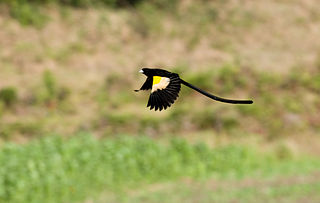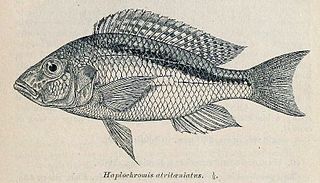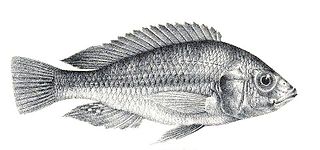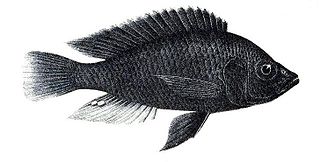
The Chilean flamingo is a species of large flamingo at 110–130 cm (43–51 in) closely related to the American flamingo and the greater flamingo, with which it was sometimes considered conspecific. The species is listed as Near Threatened by the IUCN.

The gadwall is a common and widespread dabbling duck in the family Anatidae.

The blue poison dart frog or blue poison arrow frog is a poison dart frog found in the forests surrounded by the Sipaliwini Savanna, which is located in southern Suriname (known in Surinamese Dutch as blauwe pijlgifkikker, and adjacent far northern Brazil. D. tinctorius azureus is also known by its indigenous Tirio name, okopipi. Its scientific name comes from its azure color. While frequently considered a valid species in the past, recent authorities treat it as a variant of D. tinctorius.

Protomelas taeniolatus is a Haplochromine cichlid endemic to Lake Malawi in Eastern Africa. The fish is popular in the aquarium hobby due to the bright rainbow-like colors of adult males and its relatively peaceful temperament. Juvenile and female P. taeniolatus, like many Haplochromines, do not display bright coloration.

The azure kingfisher is a small kingfisher in the river kingfisher subfamily, Alcedininae.

The haplochromine cichlids are a tribe of cichlids in subfamily Pseudocrenilabrinae called Haplochromini. This group includes the type genus (Haplochromis) plus a number of closely related genera such as Aulonocara, Astatotilapia, and Chilotilapia. They are endemic to eastern, southern and northern Africa, except for Astatotilapia flaviijosephi in the Middle East. A common name in a scientific context is East African cichlids – while they are not restricted to that region, they are the dominant Cichlidae there. This tribe was extensively studied by Ethelwynn Trewavas, who made major reviews in 1935 and 1989, at the beginning and at the end of her career in ichthyology. Even today, numerous new species are being described each year.

Haplochromis is a ray-finned fish genus in the family Cichlidae. It has been used as the default "wastebin taxon" for Pseudocrenilabrinae cichlids of the East African Rift, and as such became the "largest" fish "genus". Many of these cichlids are popular aquarium fishes; like similar Haplochromini they are known as "haplos", "happies" or "haps" among aquarium enthusiasts.

Copadichromis borleyi is a species of haplochromine cichlid fish endemic to Lake Malawi in East Africa. The species is popular in the fishkeeping hobby where it is frequently kept in aquariums. The species has numerous common names, including redfin hap and goldfin hap.

The montane widowbird, also known as the mountain marsh widowbird is a species of bird in the family Ploceidae, which is native to the eastern Afrotropics.

The black-headed weaver, also known as yellow-backed weaver, is a species of bird in the family Ploceidae.

Buccochromis atritaeniatus is a species of haplochromine cichlid. It is found in Lake Malawi in Malawi, Mozambique, and Tanzania. Its natural habitat is freshwater lakes and intermediate and sandy areas and has been caught between 10 and 40 meters; it feeds on Haplochromines and hunts in pairs or large groups. Breeding males are found in colonies at depths about 30 meters and, while breeding, build sandcastle nests on steeply sloping sandy shores. The only known threat is fisheries and is known as Haplochromis mbowe in the fishing trade. Although FishBase and the Catalog of Fishes recognise this species, the IUCN treats it as a junior synonym of Buccochromis nototaenia.
Eclectochromis lobochilus is a species of fish in the family Cichlidae. It is found in Malawi, Mozambique, and Tanzania. Its endemic to Lake Malawi.
Haplochromis sp. nov. "Blue Rockpicker" is a species of cichlid endemic to the Tanzanian part of Lake Victoria. Its natural habitat is freshwater lakes. This species grows to a length of 10.7 centimetres (4.2 in) SL.
Astatotilapia flaviijosephi, the Jordan mouthbrooder, is a vulnerable species of freshwater fish in the family Cichlidae (cichlids). It is found in the central Jordan River system, including Lake Tiberias (Kinneret), in Israel, Jordan and Syria, making it the only haplochromine cichlid to naturally range outside of Africa. This species is too small to be of significant importance to fisheries, unlike the only other cichlids native to the Levant, the economically important tilapias.

Haplochromis ishmaeli is a species of cichlid endemic to Lake Victoria though it may now be extinct in the wild. This species can reach a length of 13.6 centimetres (5.4 in) SL. A captive "insurance population" is maintained.

Haplochromis nubilus, the blue Victoria mouthbrooder, is a species of cichlid found in the Lake Victoria system in East Africa. It inhabits shallow areas near shores. This species can reach a standard length of 9.3 cm (3.7 in). It is omnivorous and feeds on algae, small crustaceans, and insect larvae.
Haplochromis piceatus is a species of cichlid fish endemic to Lake Victoria in East Africa. Although listed as vulnerable by the IUCN, surveys since 2005 have failed to find it in its home lake and it is possibly extinct in the wild. Captive "safety populations" are maintained at several public aquariums.

Haplochromis nyererei is a species of cichlid endemic to Lake Victoria in Africa. This species can reach a length of 7.7 centimetres (3.0 in) SL. The specific name honours Julius Nyerere (1922-1999) who was President of Tanzania from 1961–1985.

The electric blue hap is a species of cichlid fish endemic to Lake Malawi. It prefers to live in caves and crevices in rocky substrates. This species can reach a length of 20 centimetres (7.9 in) TL. It can also be found in the aquarium trade.

Haplochromis vonlinnei is a species of cichlid endemic to Lake Victoria. It is greyish in color with a distinct mid-lateral band, and a rather slender shape. It feeds mainly on smaller fish. This species can reach a length of 15.9 centimetres (6.3 in) SL. The population of the species has declined due to the introduction of the Nile perch in the 1950s. It has not been recorded since 1980 and the IUCN lists it as "Critically Endangered" and considers it may already be extinct. This fish is named in honour of the Swedish naturalist, Carl Linnaeus.
















